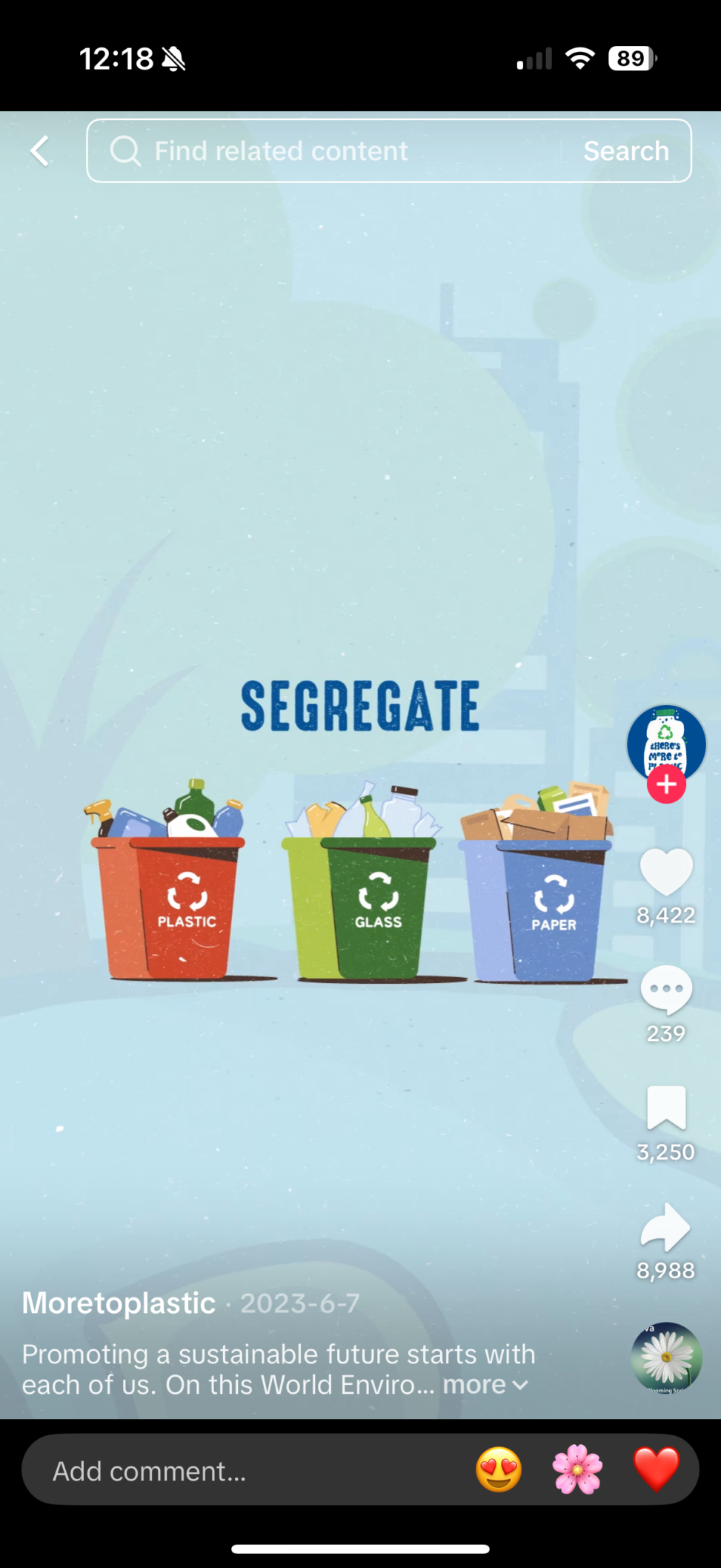Charlotte Oliver
VISA 1500
September 30th, 2025
This advertisement by Moretoplastic is trying to sell the viewers into thinking that there is more to plastic that aims for a greener and more sustainable future. 1.Break the myths | There’s more to plastic| UAE Initiative. It’s still based and shows which recycling items are thrown into the various bins.
In the advertisement photo, the psychological effects of colours and shapes with environmental aspects creates an easily explained picture with very little text. The cartoon elements inform each other such as the different garbage bins explaining how to recycle. There is nothing behind the bins except the blue background which makes it easier for viewers to just focus on the main idea of the ad. When you look closely to the foreground, you can see that other then it being a light blue, there is a tree and a building which shows that it’s taken in an outside setting.
Moretoplastic claims that there is more to plastic then we perceive. It aims to challenge myths about plastic, promote awareness, and push for a more sustainable use of plastic. 2.Break the myths | There’s more to plastic| UAE Initiative.
This company is trying to convince us as readers or an audience that we can use plastic in many different ways and accept that it can be a positive in our environment. Ensure all your household waste is properly recycled is the first step and identify which plastics can be recycled. 3.Recycling plastic at Home | There’s more to plastic.
Through the photo advertisement, you can see that it’s trying to explain how we can recycle properly and more efficiently, allowing us to use plastics in a positive way if done correctly.
1. Recycling Plastic at Home: There’s More to Plastic, accessed September 27, 2025, Recycling plastic at Home | There’s more to plastic.
2. Break the Myths: There’s More to Plastic-UAE Initiative, There’s More to Plastic, accessed September 27, 2025, Break the myths | There’s more to plastic| UAE Initiative.
3. Recycling Plastic at Home: There’s More to Plastic, accessed September 27, 2025, Recycling plastic at Home | There’s more to plastic.
I think that the advertisement could be a little more explanatory in reaching the target groups. There is no specific group that they are portraying to, however the company’s main demographic is people in the UAE (United Arab Emirates) which is a nation that is constantly evolving for a better tomorrow. I as a student/teenager may also be part of the targeted audience because might not know too much about recycling and how it works. 4.The UAE Sustainable Initiatives! – More to Plastic.
To understand in depth of what the ad is trying to convey, you have to look more into their account and search them up on Google to really understand their message.
When I look at the image, it makes it more clear to me of what recycling goes into what specific bins, but it doesn’t really inspire me to use plastic in a positive way and does not show me what I could use it for.
I did not recognize this company’s brand nor the company. There were no specific reputable sources that I could find that had information critiquing the company’s environmental manufacturing practices, however information from a UAE (United Arab Emirates) perspective talks about how plastic usage in many different forms is becoming crucial in our everyday life, even though it causes harm to both humans and animals overall. Governments want to cut back on the usage of plastic in multiple different forms but the expenses of manufacturing and selling safer products for people makes it challenging. The excessive amount of plastic wasted from used water bottles is a big concern because it has an environmental effect and is slowing down the efforts to have a greener lifestyle. 5. An Empirical Investigation on Plastic Waste Issues and Plastic Disposal Strategies to Protect the Environment: A UAE Perspective.
In this article about adverse effects of plastics, they explain that toxic chemical released during manufacture is another significant source of the negative environmental impact of plastics. A whole host of carcinogenic, neurotoxic, and hormone-disruptive chemicals are standard ingredients and waste products of plastic production, and they eventually find their way into the ecology through water, land, and air pollution. 6.Adverse-Effects-of-Plastic-on-Environment-and-Humanbeings.pdf.
4. The UAE Sustainable Initiatives!-More to Plastic, There’s More to Plastic, accessed September 27, 2025, The UAE Sustainable Initiatives! – More to Plastic.
5. Wisam Abu Jadayil, Mohamed Rafik Noor Mohamed Qureshi, Rahaf Ajaj, Eman Auil, Ghada Shawahin, Hamna Anver, and Safa Aljeawi, “An Empirical Investigation on Plastic Waste Issues and Plastic Disposal Strategies to Protect the Environment: A UAE Perspective,” Sustainability 2022, 14, no. 24, 16719. An Empirical Investigation on Plastic Waste Issues and Plastic Disposal Strategies to Protect the Environment: A UAE Perspective.
6. Adverse Effects of Plastic on Environment and Human Beings, PDF file, accessed September 29, 2025, . Adverse-Effects-of-Plastic-on-Environment-and-Humanbeings.pdf.
With the information listed above, it explains how bad plastic is for the environment and how we are trying to reduce the use of it. The company Moretoplastic did not mention the major effects that plastic is causing and that we are actively trying to get rid of it where they are trying to promote that it is a good thing and should “stay” in the environment.
This article explains how there is a positive effect of reusing plastics, explain that recycling and reprocessing plastic waste is essential for creating a sustainable circular economy. It offers an effective way to lower the need for new plastics, conserve natural resources and minimize the environmental responsibility of waste materials. 7.A systematic review of plastic recycling: technology, environmental impact and economic evaluation.
From this article you can see that they believe that plastic can be a positive thing to our environment and should be reused to a certain degree.
Moretoplastic has not changed their view on plastic and waste because of others critiquing and still aims to shift the narrative around plastics by exploring innovative solutions that maximize their benefits while minimizing their drawbacks. 8.Plastic and the Circular Economy: COP29’s Vision for Sustainable Materials.
7. X.Jiang and Buhe Bateer, “A Systematic Review of Plastic Recycling: Technology, Environmental Impact, and Economic Evaluation,” Environmental science & Technology (2025) A systematic review of plastic recycling: technology, environmental impact and economic evaluation.
8. Plastic and the Circular Economy: COP29’s Vision for Sustainable Materials, There’s More to Plastic, accessed September 27, 2025, Plastic and the Circular Economy: COP29’s Vision for Sustainable Materials.
Bibliography
-UAE Initiative. Break the Myths-There’s More to Plastic. n.d. Break the myths | There’s more to plastic| UAE Initiative.
-UAE Initiative. Recycling Plastic at Home-There’s More to Plastic. n.d. Recycling plastic at Home | There’s more to plastic.
-UAE Initiative. The UAE Sustainable Initiatives! -More to Plastic. n.d. The UAE Sustainable Initiatives! – More to Plastic.
-Abu Jadayil, Wisam, Mohamed Rafik Noor Mohamed Qureshi, Rahaf Ajaj, Eman Aquil, Ghada Shawahin, Hamna Anver, and Safa Alijeawi. “An Empirical Investigation on Plastic.
-Waste Issues and Plastic Disposal Strategies to Protect the Environment: A UAE Perspective.” Sustainability 14, no. 24 (2022)16719 An Empirical Investigation on Plastic Waste Issues and Plastic Disposal Strategies to Protect the Environment: A UAE Perspective.
-Adverse Effects of Plastic on Environment and Human Beings. n.d. PDF file.
Adverse-Effects-of-Plastic-on-Environment-and-Humanbeings.pdf.
-Jiang, Xiaoli, and Bateer Buhe. “A Systematic Review of Plastic Recycling: Technology, Environmental Impact and Economic Evaluation.” Waste Management & Research (January 18, 2025) A systematic review of plastic recycling: technology, environmental impact and economic evaluation.
-UAE Initiative. Plastic and the Circular Economy: COP29’s Vision for Sustainable Materials. n.d. More to Plastic Plastic and the Circular Economy: COP29’s Vision for Sustainable Materials.


Isabella Meade
Charlotte analyzed MoreToPlastic’s ad campaign: “Break the Myths | There’s More to Plastic | UAE Initiative.” Charlotte highlights how the ad aims to change perceptions of plastic by presenting it as part of a “greener” and more sustainable future. The ad illustrates Cartoon bins, a blue background, a tree, and a building, creating a simple, focused image. The message encourages viewers to recycle properly and consider plastic as potentially beneficial if reused.
Charlotte’s paper clearly described the visual elements of the ad and how they convey the message. She also did well in accurately identifying the ad’s purpose and intended message. Charlotte recognized that MoreToPlastic tries to rebrand plastic as environmentally positive but did not fully connect this to greenwashing tactics, although she recognized greenwashing elements and critically evaluated the ad’s environmental claims.
The company’s framing suggests plastic can be “good” if recycled, ignoring the material’s larger environmental harm. The critique could be stronger if it emphasized how this messaging distracts from the reality of plastic overproduction and pollution. Charlotte could also question the UAE’s broader political and economic motives in promoting such sustainability narratives. I appreciate that Charlotte reflected on personal Insight and how the ad may or may not influence viewers.
Charlotte included multiple credible scholarly sources, such as Sustainability (2022) and Environmental Science & Technology (2025), to support the analysis, demonstrating research effort.